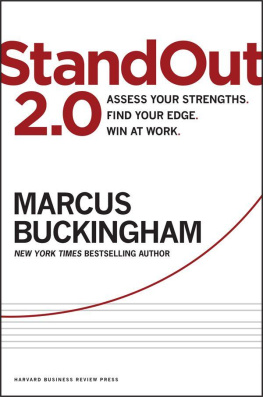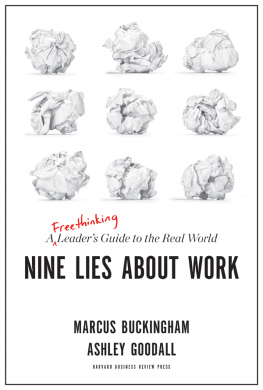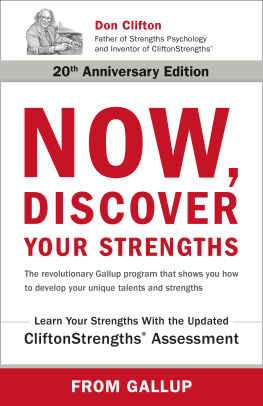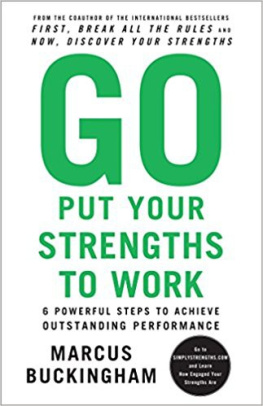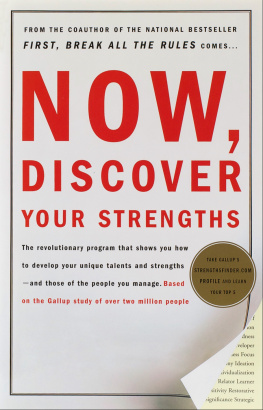StandOut
2.0
StandOut
2.0
ASSESS YOUR STRENGTHS.
FIND YOUR EDGE.
WIN AT WORK.
MARCUS
BUCKINGHAM
HARVARD BUSINESS REVIEW PRESS
BOSTON, MASSACHUSETTS
HBR Press Quantity Sales Discounts
Harvard Business Review Press titles are available at significant quantity discounts when purchased in bulk for client gifts, sales promotions, and premiums. Special editions, including books with corporate logos, customized covers, and letters from the company or CEO printed in the front matter, as well as excerpts of existing books, can also be created in large quantities for special needs.
For details and discount information for both print and ebook formats, contact .
Copyright 2015 One Thing Productions, Inc.
All rights reserved
No part of this publication may be reproduced, stored in or introduced into a retrieval system, or transmitted, in any form, or by any means (electronic, mechanical, photocopying, recording, or otherwise), without the prior permission of the publisher. Requests for permission should be directed to , or mailed to Permissions, Harvard Business School Publishing, 60 Harvard Way, Boston, Massachusetts 02163.
The web addresses referenced in this book were live and correct at the time of the books publication but may be subject to change.
Library of Congress Cataloging-in-Publication Data
Buckingham, Marcus.
StandOut 2.0 : assess your strengths, find your edge, win at work / Marcus Buckingham.
pages cm
ISBN 978-1-63369-074-5 (hardback)
1. Employee motivation. 2. Ability. 3. Success. 4. PerformancePsychological aspects. I. Title.
HF5549.5.M63B833 2015
650.1dc23
2015009861
Contents
PREFACE
Birthday WishesToward a Stronger Future
Its Sunday, a rainy Sunday in Los Angeles, and, as it happens, my birthdaya good day to stop and look back. Fifteen years ago, in First, Break All the Rules, my colleagues at Gallup and I presented the world with a deceptively simple discoverythat although the worlds best managers have different styles, personalities, and methods, they all share one insight: to get the most out of people, you must build on their strengths and manage around their weaknesses. This might seem like common sense to you, but it caused quite a stir because, at the time, all management thinking and practice was based on the conviction that, to help people grow, you must first fix them. Pinpoint their weaknesses, label these areas of development or areas of opportunity, and then work diligently to turn these weaknesses into strengths. In this remedial world, a world in which polls revealed a global fascination with fixing weaknesses, this strengths-based approach was an eye-opening jolt to the conventional wisdom.
Not so anymore. If you walked into the offices of Harvard Business Review today and announced that the best managers focus on strengths, the staff would nod politely and say, Yes, thank you. We know. In the intervening years, this unconventional truth has become conventional. Positive psychology is now one of the most fertile and popular fields for academic research, appreciative inquiry has taken hold as a model for strengths-based organizational change, and more than nine million people have taken the StrengthsFinder assessment, introduced in my second book Now, Discover Your Strengths. In fact, this truth is now so widely held that one sure-fire way to get peoples attention is to rail against ithence, books such as Fear Your Strengths and articles with titles like When Your Strengths Become Your Weaknesses.
Yet, look more closely and you discover something rather odd. Although the strengths-based approach to managing people is now conventional wisdom, the forms and systems for people inside organizationsthe performance appraisal forms, the training interventions, and succession planning systemsremain stubbornly remedial. When you have your first performance reviewand every performance review thereafteryou will still be rated on how you stack up against a preset list of competencies, your gaps will be identified, and you will be told that to secure a bigger bonus and a desirable promotion, you must knuckle down and plug your skill gaps. Management theory and management practice have become separated and are now utterly and unhelpfully out of sync. Its as if we are now all aware that the earth is round, yet our maps and navigation tools persist in representing it as flat.
What to do? This is no idle question, because when it comes to revolutionsand we were certainly trying to start onethe forms and processes always trump the ideas. The forms always win. Change the ideas and keep the forms the same, and you will have changed little. Teach people that to excel they must discover and apply their strengths, but leave in place all the remedial forms and systems, and all you will net is confusion and frustration and an inexorable slide back to the old ways of doing things.
This is where we all are today. The situation is undoubtedly frustrating and unproductive for students, team members, team leaders, and organizations the world over. To remove these frustrations, increase productivity, and bring actual practice up to date with thinking, my team and I created this new version of StandOut.
First, weve taken the StandOut strengths assessment and dramatically increased its power. When we launched it in 2011, it was an assessment that simply identified your most dominant strengths and then presented them to you in a report. This was useful, though, like all reports, it inevitably wound up hidden in a drawer somewhere, alongside your StrengthsFinder report, Myers-Briggs report, and all the other personality tests you may have taken. Being made aware of your strengths at a point in time is one thing, but if youre not deliberate about keeping your strengths front and center, then peopleincluding yougradually lose sight of them, leaving you vulnerable to the distractions of weakness-fixing forms and systems.
To make your strengths visible, we designed for you a StandOut Snapshot that you can use to present the very best of yourself to your team and your company. Based on your assessment results, the snapshot describes your greatest value to any team and what others need to know to see you at your best. You can customize these insights as you see fit and post any pictures, videos, articles, or quotes that you think will add to peoples understanding of you at your best at work. You can export this snapshot to LinkedIn, Facebook, or any other social network, where its unique contribution will always be to present your strengths to the world credibly, precisely, and vividly. Of course, if you happen to lead a team, you can make a team dashboard where each persons snapshot will serve as your cheat sheet to help you know the right moves to make with each team member.
Second, we wanted to give you a way to keep learning. After all, the point of teaching you about your strengths is to help you excel, and excellence, as Aristotle reminds us, is created not by one act but by what you repeatedly do. So, to guide what you repeatedly do, this new version of StandOut provides you with your own personal learning channel. Once youve completed the fifteen-minute online assessment, you will receive not only your report with the ranking of your strengths and action suggestions, but also a weekly tip, insight, technique, or idea, something that will help you know how you can do your best work this week. Faced with a noisy world that is ignorant of you and your strengths, this weekly pulse will help you take a stand for what you bring to your team and your organization and guide you to bring it most intelligently.
Third, we made the StandOut assessment the front door to an online performance system
Next page
